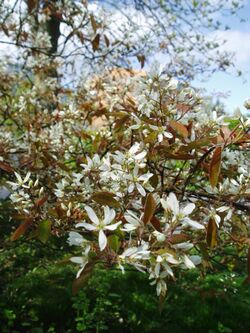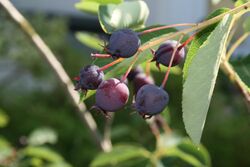Biology:Amelanchier lamarckii
| Amelanchier lamarckii | |
|---|---|

| |

| |
| Scientific classification | |
| Kingdom: | Plantae |
| Clade: | Tracheophytes |
| Clade: | Angiosperms |
| Clade: | Eudicots |
| Clade: | Rosids |
| Order: | Rosales |
| Family: | Rosaceae |
| Genus: | Amelanchier |
| Species: | A. lamarckii
|
| Binomial name | |
| Amelanchier lamarckii F.G.Schroed.
| |
Amelanchier lamarckii, also called juneberry, serviceberry or shadbush, is a large deciduous flowering shrub or small tree in the family Rosaceae.
Description
In spring the plant unfurls new leaves and produces star-shaped white flowers.[1] The leaves are pink when they first open, maturing to yellow-green, and turn red in autumn.[1] The plant's young berry-like pome fruits are dark red when young, but become dark purple when ripe.[2]
Taxonomy
This form is an apomictic microspecies presumed to be of hybrid origin[3] (A. laevis and either A. arborea or A. canadensis); therefore under the rules of botanical nomenclature, it would be known as Amelanchier × lamarckii. The Latin specific epithet honors the French naturalist Jean-Baptiste Lamarck (1744–1829).[4]
The European common name snowy mespilus[2] (a name which is also attached to the related A. ovalis) reflects its close relationship with the medlar genus, Mespilus. It is also known as snowy mespil.[5]
Distribution and habitat
The plants are originally from eastern Canada and widely naturalised in Europe.[2] There has been some escape within North America of plants apparently secondarily derived from those European forms.[6]
Ecology
The fruit is eaten by birds soon after it ripens.[2]
Cultivation
The species is widely cultivated as an ornamental plant. It has gained the Royal Horticultural Society's Award of Garden Merit.[2]
Uses
Like other species of Amelanchier,[7] the fruits are edible with a sweet flavor.
References
- ↑ 1.0 1.1 "Snowy mespilus". BBC Plantfinder. http://www.bbc.co.uk/gardening/plants/plant_finder/plant_pages/41.shtml.
- ↑ 2.0 2.1 2.2 2.3 2.4 "Amelanchier lamarckii". https://www.rhs.org.uk/Plants/26602/Amelanchier-lamarckii/Details.
- ↑ Rushforth, Keith (1999). Collins Guide to the Trees of Britain and Europe. Harper Collins. pp. 503–4.
- ↑ Harrison, Lorraine (2012). RHS Latin for Gardeners. United Kingdom: Mitchell Beazley. ISBN 978-1845337315.
- ↑ "Collins English Dictionary". http://www.collinsdictionary.com/dictionary/english/snowy-mespil.
- ↑ Campbell, Christopher S.; Burgess, Michael B.; Cushman, Kevin R.; Doucette, Eric T.; Dibble, Alison C.; Frye, Christopher T. (2015), "Amelanchier Medikus, Philos. Bot. 1: 135, 155. 1789", in Brouillet, L.; Gandhi, K.; Howard, C.L. et al., Magnoliophyta: Picramniaceae to Rosaceae, Flora of North America North of Mexico, 9, Oxford University Press, http://www.efloras.org/florataxon.aspx?flora_id=1&taxon_id=101333
- ↑ "Amelanchier, A Very Tasty Wild Edible Fruit" (in en-US). 2013-07-13. https://eattheplanet.org/amelanchier-a-very-tasty-wild-edible-plant/.
External links
- "Amelanchier lamarckii". http://www.pfaf.org/user/Plant.aspx?LatinName=Amelanchier+lamarckii.
- Information from the Missouri Botanical Garden
Wikidata ☰ Q161702 entry

